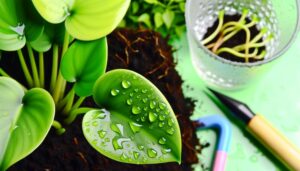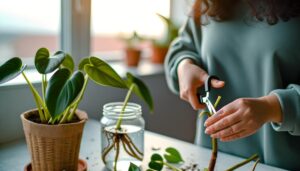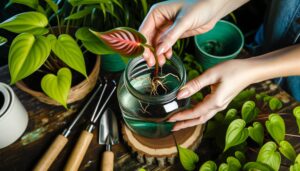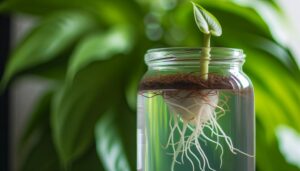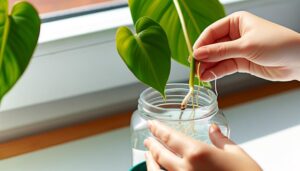How to Propagate Ecuador Philodendron? Easy Steps!
To propagate an Ecuador Philodendron, first sterilize sharp pruning shears. Select a healthy, disease-free stem with at least three to four nodes.
Cut precisely below a node at a 45-degree angle. Dip the cut end in rooting hormone containing auxins.
For soil propagation, use a well-draining mix like perlite and sphagnum moss, and insert a node-submerged cutting. Maintain high humidity and consistent ambient temperature.
Monitor for root development and transplant once a robust root system forms. Continue caring for the new plants, ensuring best light and moisture conditions.
Stay informed for detailed procedural insights and advanced propagation techniques.
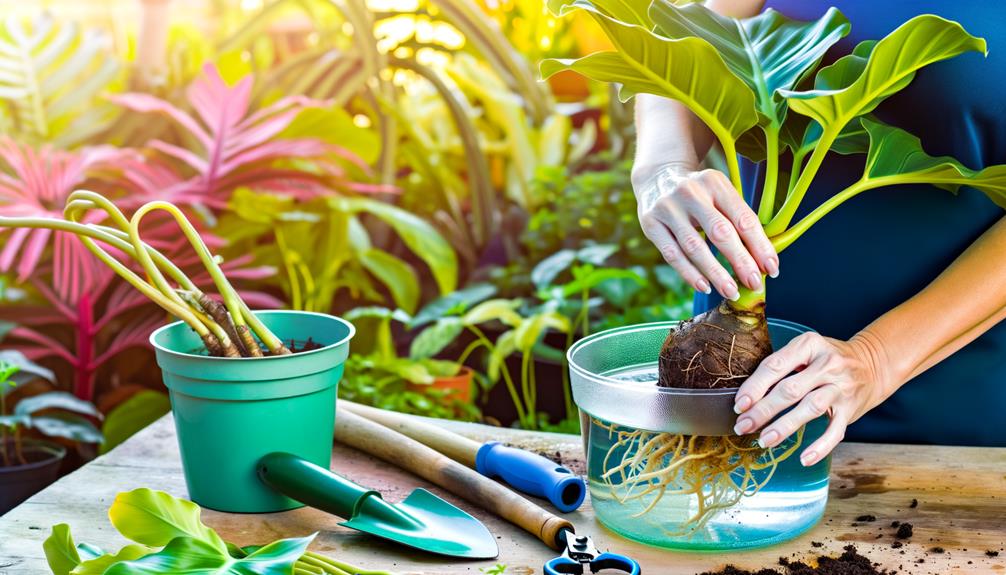
Key Takeaways
- Select a healthy Ecuador Philodendron stem with at least three nodes and vibrant green leaves.
- Use sterilized, sharp pruning shears to make a 45-degree cut just below a node.
- Apply rooting hormone to the cut end to encourage root development.
- Insert the cutting into a well-draining propagation medium like perlite or sphagnum moss.
- Maintain high humidity, indirect sunlight, and keep the medium moist but not waterlogged.
Choosing the Right Tools
Selecting the appropriate tools is crucial for successful propagation of the Ecuador Philodendron, maximizing both the plant’s health and the efficiency of the process.
- First, a pair of sterilized, sharp pruning shears is essential to make clean cuts, reducing the risk of plant tissue damage and infection.
- A rooting hormone, containing auxins, promotes root initiation and enhances the establishment of cuttings.
- Additionally, a sterile propagation medium, such as a mixture of perlite and sphagnum moss, provides prime aeration and moisture retention.
- Transparent plastic bags or propagation domes create a humid microenvironment conducive to root development.
- Finally, labeling tools ensure accurate tracking of propagation timelines and plant identification.
Properly selected tools streamline the propagation process, fostering healthy Ecuador Philodendron growth.
Selecting a Healthy Plant
After assembling the necessary tools, identifying a robust and disease-free parent plant is essential to guarantee successful propagation of the Ecuador Philodendron.
Begin by examining the foliage for signs of vigor, such as vibrant green coloration, absence of chlorosis, and firm texture. Inspect the stems and petioles for lesions, discoloration, or fungal growth. A healthy plant will exhibit consistent growth patterns and minimal leaf drop.
Additionally, assess the root system if accessible; healthy roots should be white and firm, devoid of rot or pest infestation. Ensuring the parent plant is well-hydrated and has received balanced fertilization will enhance its overall resilience and propagation success.
Identifying the Best Stem
To identify the best stem for propagation, focus on selecting a segment that is both mature and vigorous, characterized by multiple nodes and healthy, unblemished leaves. Confirm the chosen stem exhibits robust growth, indicative of peak nutrient uptake and photosynthetic efficiency.
Nodes are critical, as these sites contain meristematic tissue, essential for root initiation. Prioritize stems with at least three to four nodes, ensuring a higher success rate in propagation.
Additionally, inspect for any signs of pathogens or pests, as these can compromise the health of the new plant. The presence of aerial roots is advantageous, as they can expedite root development post-propagation.
This meticulous selection process guarantees a strong start for your new Ecuador Philodendron.
Making the Cut
Using sterilized pruning shears, make a precise incision just below a node to create optimal conditions for root development. Confirm the blade is clean to prevent pathogen transfer, which could endanger the cutting’s viability. The incision should be neat and at a 45-degree angle to maximize the surface area for nutrient absorption.
Careful incising is essential for:
- Enhancing root formation
- Reducing the risk of disease
- Promoting vigorous growth
Select a healthy stem that displays signs of vitality, such as solid texture and vivid color. The spacing between nodes should be adequate to include one or two. Execute the incision with steady hands to avoid damaging the stem tissue, which can hinder the propagation process.
Preparing the Cutting
To guarantee successful propagation of the Ecuador Philodendron, it is vital to select healthy stems exhibiting vigorous growth and free from pests or diseases.
Utilizing precise cutting tools, such as sterilized pruning shears or a sharp scalpel, is essential to minimize tissue damage and prevent pathogen transmission.
Sterilizing the equipment with a solution of isopropyl alcohol or sodium hypochlorite will further reduce the risk of microbial contamination, thereby encouraging ideal rooting conditions.
Sterilizing the Equipment
Implementing the cutting tools’ proper sterilization is crucial to preventing the introduction of pathogens that could compromise the health of the Ecuador Philodendron. To achieve this, systematically follow these steps:
- Prepare a sterilizing solution: Combine one part bleach with nine parts water or use 70% isopropyl alcohol.
- Immerse the tools: Submerge the cutting implements in the solution for a minimum duration of 5 minutes.
- Rinse and dry: Thoroughly rinse the tools with distilled water and allow them to air dry on a clean surface.
These meticulous steps guarantee that bacterial and fungal contaminants are eradicated, safeguarding the plant’s integrity. Adhering to this protocol is essential for successful propagation and the long-term health of the Ecuador Philodendron.
Rooting in Water
To achieve successful rooting in water, it is crucial to select healthy cuttings that exhibit no signs of disease or stress.
Utilize a sterile water container, making sure it is appropriately sized to support the cuttings without overcrowding.
Consistently monitor the root development, maintaining water quality by changing it regularly to prevent microbial growth and ensure ideal rooting conditions.
Selecting Healthy Cuttings
When selecting healthy cuttings for rooting in water, prioritize stems exhibiting robust development, free from illness or pest infestations, and with at least one node and two to three leaves.
Choose cuttings from the middle part of the plant, guaranteeing the following attributes:
- Robust Growth: Select stems that show active growth, characterized by healthy, vibrant leaves.
- Lack of Pathogens: Avoid cuttings showing signs of disease or pest damage, as these can compromise rooting success.
- Optimal Node Count: Guarantee the cutting contains at least one node, as nodes are critical sites for root development.
Utilizing these criteria will enhance the likelihood of successful propagation, providing a solid foundation for the cutting’s progression to water rooting and subsequent growth phases.
Preparing Water Container
Properly preparing the water container is essential for establishing an ideal environment conducive to root development, ensuring the water used is free from contaminants and the container itself is sterile.
Begin by selecting a transparent glass or plastic container, allowing for easy observation of root formation. Sterilize the container using a diluted bleach solution (one part bleach to ten parts water) to eliminate pathogens. Rinse thoroughly with distilled water to remove any residual bleach.
Fill the container with filtered or distilled water, ensuring it is at room temperature. Avoid tap water as it may contain chlorine and other chemicals detrimental to root growth. Submerge the cuttings so that only the nodes are submerged, ensuring the best oxygen and nutrient exchange.
Monitoring Root Growth
Regularly examining the cuttings at intervals of three to four days is important for evaluating root development and maintaining optimal conditions for successful propagation.
During these inspections, observe the cuttings for initial root emergence, typically appearing as small white nodules. Make sure water remains clear and replace it if cloudiness or algae is detected, as these can hinder root growth.
Key steps include:
- Monitoring for root rot: Look for any signs of browning or mushiness, indicating potential rot.
- Checking water quality: Maintain cleanliness to prevent bacterial growth that could jeopardize root health.
- Ensuring sufficient light: Provide indirect sunlight, as excessive direct light can stress the cuttings.
Consistent monitoring fosters strong root systems, important for transplant success.
Rooting in Soil
To start the rooting of an Ecuador Philodendron in soil, it is important to select a well-draining potting mix that maintains ideal moisture levels while preventing root rot. Utilize a blend comprising equal parts of perlite, orchid bark, and peat moss, ensuring excellent aeration and moisture retention.
Begin by making a small hole in the center of the potting mix and gently insert the cut end of the Philodendron cutting, ensuring at least one node is submerged. Firmly press the soil around the cutting to provide stability.
Maintain ambient temperatures between 20-25°C (68-77°F), as this range promotes root development. Regularly monitor the moisture content, keeping the soil evenly moist but not waterlogged, to facilitate successful rooting.
Providing Proper Care
Providing best care for Ecuador Philodendron involves maintaining specific environmental conditions to promote healthy growth. Key factors include ensuring ideal light conditions, which involve indirect but bright light to prevent leaf burn, and managing watering routines to maintain consistent soil moisture without waterlogging.
Additionally, maintaining high humidity levels, ideally between 60-80%, is essential for mimicking the plant’s native tropical habitat.
Ideal Light Conditions
Best light conditions for the Ecuador Philodendron involve bright, indirect sunlight, which mimics the dappled light of its natural understory habitat. This plant thrives when positioned in an environment that allows it to receive filtered light, avoiding direct sunlight which can cause leaf scorching.
To achieve the best growth:
- Place the Philodendron near an east or north-facing window.
- Use sheer curtains to diffuse harsh sunlight.
- Rotate the plant periodically to ensure even light distribution.
Maintaining these conditions promotes photosynthesis without stressing the plant, thereby enhancing its overall health and vigor.
Monitoring light levels with a light meter can be particularly beneficial in achieving the right balance. Correct lighting conditions are essential for the propagation and sustained growth of the Ecuador Philodendron.
Watering and Humidity
Ensuring perfect watering and maintaining suitable humidity levels are necessary for the health and growth of the Ecuador Philodendron. Water the plant when the top inch of soil becomes dry, ensuring thorough drainage to prevent waterlogging, which can lead to root rot. Employ a well-aerated potting mix to facilitate best water retention and drainage.
Relative humidity levels should be maintained between 60-80%. Utilize a hygrometer to monitor ambient moisture levels and employ a humidifier or humidity tray if necessary. Misting the leaves can also aid in achieving the desired humidity.
Consistent humidity and proper watering practices are essential for the physiological processes of photosynthesis and transpiration, promoting robust growth and vibrancy in the Ecuador Philodendron.
Monitoring Growth
Regular assessment of the philodendron’s growth parameters is essential for optimizing its propagation success.
It is critical to systematically monitor and document the following:
- Leaf Morphology: Observe and record the dimensions, color, and texture of newly emerged leaves.
- Root System Development: Periodically unearth the plant to evaluate root length, density, and branching patterns.
- Overall Plant Vigor: Assess the plant’s resistance to disease, pests, and environmental stressors.
Utilize tools such as calipers for leaf measurement and a magnifying glass for close root inspection. Consistent monitoring enables early detection of growth abnormalities, facilitating timely intervention.
This meticulous approach guarantees the philodendron’s robust development during the propagation phase.
Transplanting New Plants
Upon reaching adequate root development, the young philodendrons should be carefully transplanted into their new containers to guarantee continued growth and stability. Select a pot with sufficient drainage holes to prevent waterlogging and root rot.
Use a well-draining, aerated potting mix, ideally containing components such as peat moss, perlite, and orchid bark to replicate the natural habitat.
Gently remove the plant from its initial container, taking care not to damage the delicate root system. Position the plant in the new container at the same depth it was previously growing, then fill in with the potting mix.
Water the plant thoroughly to settle the soil, and place it in a location with indirect sunlight to mitigate transplant shock and promote acclimatization.
Conclusion
The meticulous process of propagating an Ecuador Philodendron, when reduced to its essence, is a marvel of nature’s simplicity disguised as a horticultural ordeal.
From the selection of sterile tools to the identification of a strong stem, each step embodies a botanical rite of passage.
One might jest that such precision rivals the complexity of molecular gastronomy, yet the ultimate goal of lush, verdant growth is a tribute to the practitioner’s unwavering dedication.
Truly, propagation is not for the faint-hearted.

